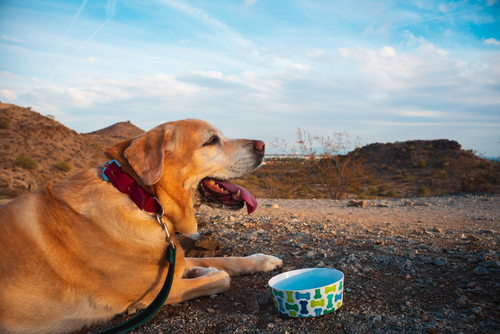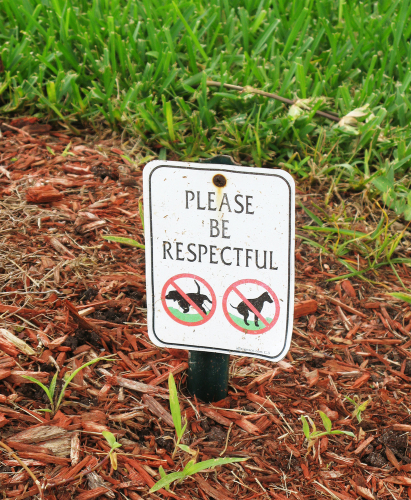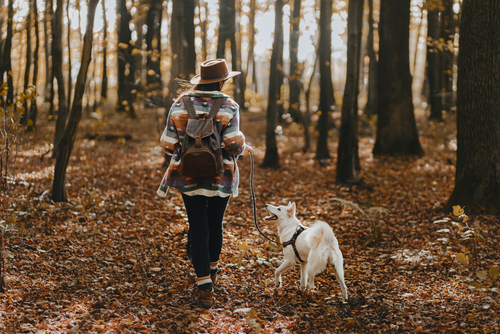5 Things To Know About Hiking With Dogs
Posted: 11/08/2022 | BY: Lacy Bursick | Categories: Dog , Pet care , Top Tips
Spring is here which means outdoor activities are incoming. If you are like me, I always hit the trail with my dogs because they are the best hiking companions I could ever ask for. Living in a pet-friendly area, there are always a lot of other dogs on the trails. For pets with issues like leash aggression, this can be overwhelming. To be a responsible pet owner, it is important to prepare before hiking with dogs.
Here are 5 things everyone should know about hiking with dogs.

1. Always Bring A Water Bowl
You grabbed your Camelbak or water bottle, but did you grab a bottle and bowl dedicated to your dog? Dogs can experience dehydration too, and it can lead to heat stroke and other serious illnesses. If you are out of breath and need a drink, then your pet certainly does too.
Carrying around a dog bowl can be annoying, but luckily there are many convenient options. There are pop-up water bowls that can hook to your backpack. There are also water bottles with built-in bowls for quick and easy access. It is recommended by the American Hiking Society to carry 8 ounces of water per hour, per dog. That means you need over 1L for 5 hours of hiking with dogs. This can be a lot of extra weight, but there are doggie backpacks that you can outfit your pooch in so they can carry their own gear.
2. Pick Up Their Poop
When you are hiking, you want to always practice “Leave No Trace” and pack it in, pack it out. It is a simple concept: be responsible for your own trash and do not leave your dog’s poop on a trail. A responsible pet owner should always have waste bags on hand. Nowadays there are even convenient clip-on bag holders that you should have on their leash at all times.
There is a huge environmental impact from dog poop. According to a study by Open Space and Mountain Parks in Boulder, Colorado, only 73% of dog owners pick up their dog’s waste when hiking with dogs. They estimated that is 60,000 pounds of dog poop per year in their 150 acres of hiking trails.

You may think, a bear poops in the woods, why can’t my dog? An animal local to the environment will be foraging plants in the native ecosystem. Through its waste, or often known as skat, the same resources are returned to the ecosystem.
Your dog most likely is not eating foods native to wherever you are hiking, so its waste is introducing things like extra nitrogen or phosphorus into the environment. A build-up of waste like this can lead to toxic algae blooms or invasive species. To avoid this situation, always pick up your dog’s feces and dispose of them in a trash receptacle.
3. Check To Make Sure Dogs Are Allowed
It is always smart to check if dogs are allowed on a trail before taking them there. AllTrails is a great resource that will tell you if dogs are allowed, and also gives updates on trail conditions. National Parks do not allow dogs on trails, but they are allowed at campsites, for example.
If you are planning to explore a National Park, it’s best to leave dogs at home. If a trail says no dogs, you should always respect the rule. You could be faced with a large fine. But also, it is most likely unsafe for your dog or the environment if a particular trail says no dogs.

4. Practice Trail Etiquette
When you are hiking with your dog, you are responsible for your dog’s actions as well as your own. The first golden rule is to always have your dog on a leash unless your dog can follow strict voice commands to heel, every time. When you are passing other hikers, bikers, horseback riders, or other animals, your pet should not cause a disturbance.
It is best practice to yield to anyone passing on a trail and keep your dog safely away from passersby when hiking with dogs. If passing horses, for example, you always want to yield. When passing another dog owner, keep your dog out of the way of getting sniffed or causing a potential leash aggressive encounter.
Even if your dog is well-behaved and friendly, other dogs may not be. It is also good trail etiquette to let the hikers ascending have the right-away. Hikers who are descending are usually looking down the trail and can usually step out of the way more conveniently. Just remember to always be respectful to your environment, animals, and other trail users.

Protect Your Dog With Preventive Care
Before ever hiking with dogs, you want to ensure your dog will be safe from anything in the environment. You will want your dog to be fully vaccinated beforehand, so they are safe from diseases that could be present in the water or other animals. These critical vaccinations includes rabies, distemper, and more.
Your vet will have the best knowledge for your area, and if you plan on doing a lot o hiking with dogs, it is best to protect them from everything possible. Getting additional vaccines such as leptospirosis, which is a deadly virus often found in water outdoors, is a smart move.
Additionally, you will want to have tick, flea, and heartworm prevention to keep your dog safe from contracting Lyme Disease or getting any parasitic-related issue. It is recommended to talk to your vet and discuss all the best preventative methods for hiking with dogs.
Pet insurance can reduce the cost of preventative care, so get a quote today to compares rates and plans so your dog can be safe.
Disclaimer
The information contained on this blog is intended for informational and educational purposes only and should not be construed as medical advice. It is not a substitute for professional veterinary care. Always consult with your veterinarian before making any changes to your pet's health care or treatment plan.
The authors of this blog are not veterinarians and do not claim to be experts in pet health. The information provided here is based on our own experiences and research, as well as information from reputable sources. However, we cannot guarantee the accuracy or completeness of this information.
We encourage you to do your own research and consult with your veterinarian before making any decisions about your pet's health.
Previous post
4 Dog Training Tips For Leash AggressionNext post
Common Cancers in DogsCompare top pet insurance providers & plans.
Enter your dog’s age in years and months to calculate their age equivalent to human years.
Calculate your dog’s ageEnter your cat’s age in years and months to calculate their age equivalent to human years.
Calculate your cat’s age